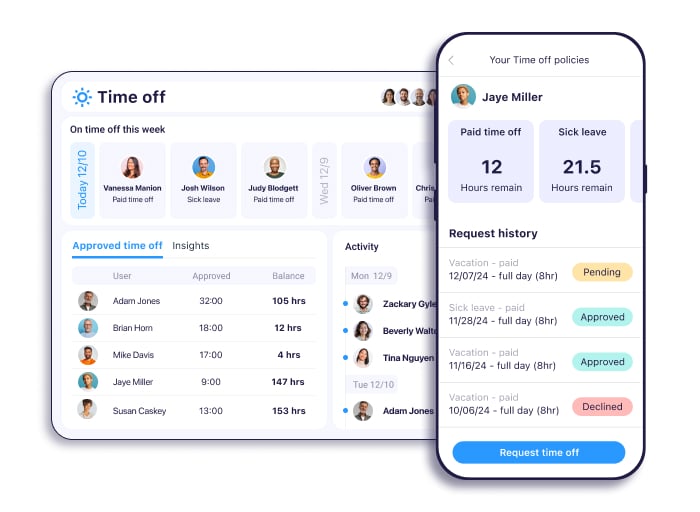When managing a field-based or remote team, choosing the right time tracking tool can directly impact productivity, compliance, and team morale.
Pick the wrong one, and you could end up with inaccurate timesheets, frustrated field workers, or monitoring tools that feel more invasive than helpful.
Connecteam and Time Doctor are popular time tracking solutions, but how do they stack up? I’ve tested both platforms, and below, I compare them side by side to help you choose the one that’s right for your business.
A note about our method: All product comparisons and verdicts in this guide are based on hands-on testing by our expert team. Every screenshot was taken from real use during our evaluation.
At a Glance: Quick Summary
Connecteam is a comprehensive workforce management solution, combining GPS time tracking, scheduling, team communication, and task management in a user-friendly mobile app. It’s ideal for construction, cleaning, security, healthcare, and other field-based and frontline businesses that need more than just time tracking.
Time Doctor is an employee monitoring tool known for its productivity tracking, including screenshot capture, activity levels, and web usage tracking. It’s designed for remote teams and businesses that bill clients by the hour and need detailed proof of work. However, its monitoring features can feel invasive, and it has some accuracy issues.
Pricing and Plans
| Plan Type | Connecteam (Operations hub) – Monthly/User (billed annually) | Time Doctor – Monthly/User (billed annually) |
| Free Trial | Yes, 14 days | Yes, 14 days |
| Free Plan | Up to 10 users with basic time tracking, GPS, and messaging | ❌ Not available |
| Basic | $29/month for first 30 users, then $0.80 per additional user Adds scheduling, reports, and GPS tracking | $6.70/user Includes basic time tracking, screenshots, and reports |
| Pro tier | Advanced $49/month for first 30 users, then $2.50 per additional user Adds forms, checklists, and advanced reporting | Standard $11.70/user Adds integrations, payroll features, and activity tracking |
| Premium tier | Expert $99/month for first 30 users, then $4.20 per additional user Adds unlimited shift task & geofence sites, auto reports, API access | Premium $16.70/user Adds video screen recording, mouse jiggler detection, and AI reports |
| Enterprise | Custom Adds unlimited time clocks & schedules, 2-factor authentication, and a personal success manager | Custom Adds custom BI dashboards and private cloud deployment & support |
| All prices show the monthly cost when billed annually as of October 2025. | ||
I appreciate that Connecteam divides its pricing across three hubs: Operations, Communications, and HR & Skills. Each hub has tiered plans—Basic, Advanced, and Expert—all with a flat monthly rate for up to 30 users, plus a minimal per-user charge beyond that.
For example, the Operations Basic plan is $29/month for your first 30 people, with just $0.80/month per user beyond that. If you need features across multiple hubs, you stack them. So, subscribing to basic-level plans for all three hubs would cost you $87/month for 30 users and only slightly more per additional user.
Time Doctor, on the other hand, charges strictly per user, with pricing tiers that reflect increasing levels of features. The Basic plan is $6.70/user/month, billed annually. That means for a 30-person team, you’d pay $201/month. That’s around 7x the cost of Connecteam’s flat-rate option.
I understand that Time Doctor offers advanced monitoring tools and productivity AI in its higher tiers. But from a budgeting perspective, it’s a tough sell unless surveillance-level analytics are your top priority.
Pros and Cons
Connecteam pros
- Comprehensive, easy-to-use mobile app
- GPS tracking and geofencing work reliably without draining battery
- Free plan supports up to 10 users with core features
- All-in-one platform reduces need for multiple tools
Connecteam cons
- No offline mode
- Lacks built-in video conferencing
Time Doctor pros
- Detailed productivity monitoring with screenshots and activity tracking
- Strong integration ecosystem with 60+ tools
- Detailed reporting for client billing and compliance
- Offers offline mode
Time Doctor cons
- Mobile app extremely limited compared to desktop functionality
- Accuracy issues with time tracking
- Invasive monitoring features may hurt team morale
- Performance issues can slow down devices
Use Cases
Connecteam is best for:
- Field and frontline team management: GPS tracking, job site check-ins, and mobile-first design make it perfect for construction crews, cleaning teams, healthcare workers, and other professionals who are rarely at a desk.
- All-in-one workforce management: Beyond time tracking, you get scheduling, task management, team chat, and employee management in one platform.
Time Doctor is best for:
- Client billing and compliance: Screenshot capture, detailed activity reports, and precise time tracking (when it works correctly) provide the documentation needed for hourly billing and audit requirements.
- Remote team productivity monitoring: If you need to track what remote employees are doing during work hours, Time Doctor’s monitoring features provide detailed insights into app usage, websites visited, and activity levels.
Connecteam vs. Time Doctor: Side-by-Side Feature Overview
Both Connecteam and Time Doctor offer time tracking capabilities, but their approaches to field and frontline teams, mobile functionality, and workforce management differ significantly. Below, I break down the most important features for deskless workforces.
Time tracking and location enforcement – Winner: Connecteam
When I started testing the two platforms, Connecteam immediately felt tailor-made for field teams.
With the time clock app, I could track time (down to the second) via mobile, web, or a shared kiosk using selfie or PIN verification to prevent buddy punching. For admins, that level of control over shift integrity is a big deal. And for employees, it’s straightforward: They open the Connecteam app, clock in with just a few taps, and they’re good to go.
Connecteam also doubles as a real-time GPS tracker, with GPS tracking and geofencing (two features I feel take time tracking to the next level) built directly into the time clock.
You can quickly set up a geofence around a job site, and it will restrict clock-ins to only that location. That meant no one could clock in early from the parking lot, or worse, from home. For field workers, this provides clarity, too. They know Connecteam will accurately log their location and time, helping avoid disputes.
I also loved the breadcrumb GPS trail. You can see where your field staff has been during the day, which helps with both accountability and dispatch planning. Employees can log mileage or note delays directly on their shift, making reporting way more efficient.
A major plus here is that Connecteam stops recording employees’ locations as soon as they clock out.

Time Doctor takes a different approach to time tracking.
I found the desktop timer easy to use (with simple start, pause, and stop functionality), but it’s more suited for monitoring productivity than managing logistics. Idle time detection worked well and automatically stopped tracking when I was inactive, which is great for freelancers or billable-hour teams.
But when I needed to know where someone was working, Time Doctor fell short. There’s no GPS tracking, no geofencing, and no location history. That’s a big miss if you manage crews in the field.
It does let you record screenshots or even videos (on the Premium plan), and I appreciated the productivity scores based on app and website usage. But that’s only useful if you’re sitting at a desk.
I also ran into some sync issues when switching between the mobile and desktop apps on the same day. (Time Doctor even warns about this in its help docs, so it’s a longstanding issue.) Plus, switching tasks wasn’t seamless. I had to manually stop one timer and start another when juggling multiple projects. That friction adds up.

In the end, Time Doctor helps you understand how people are working, while Connecteam helps you manage where and when they’re working. Connecteam takes the cake in this category for that reason, plus its stronger features and more seamless experience.
PTO and leave management – Winner: Connecteam
Connecteam’s time off management system handles the complex accrual rules that plague many businesses.
For starters, you can configure different policies for full-time vs. part-time workers. You can vary accrual rates based on tenure (such as 1 day per month for the first year, 1.5 days for the second year, etc.), and maintain separate banks for vacation, sick time, and personal days.
The system automatically calculates accruals based on hours worked, not just calendar time, which is crucial for field workers with irregular schedules.

Employees can submit leave requests directly through the mobile app for vacation, sick leave, or unpaid time off. Once they make a request, managers receive instant alerts and can make approvals in seconds.
I love that Connecteam takes things a step further by automatically syncing approved leave time with the team schedule and employees’ timesheets. This reduces manual cross-checking of leave records and ensures that no shifts overlap with approved time off.
What really stood out to me is Connecteam’s functionality for customizing leave types, setting blackout periods, and controlling which employees can request which type of leave.
This level of control is especially valuable for businesses looking to prevent overstaffing and avoid miscommunication. Employees can easily check their leave balance and availability without needing to rely on HR, ensuring a smooth and transparent process.
In comparison, Time Doctor’s approach to time-off is practically Stone Age: manual CSV file uploads to track balances, no approval workflows, and no integration with scheduling or payroll systems.
Managers must manually track employee time off, process requests via email or verbal communication, and ensure that approved time off is excluded when building schedules.
For any business beyond a handful of employees, this manual approach creates constant administrative headaches and compliance risks.
Project management and task tracking – Winner: Connecteam
Connecteam’s task management app feels purpose-built for real-world execution. During testing, I could assign tasks with clear checklists, attach files or photos, and set due dates.
Once a task is set, employees get instant mobile notifications and can respond with updates, notes, or proof-of-work photos directly in the app. One feature I found super useful is the ability to add client contact info or special job instructions to each task. It made dispatching much more streamlined.

Meanwhile, Time Doctor handles projects more from a billing and budgeting angle than operational task tracking.
You can set up projects, assign employees, and define hourly budgets or cost estimates. That’s handy when you’re trying to keep tabs on how much a client engagement is costing. As hours get logged, Time Doctor will show you burn rates and how close you are to the original budget.
But it stops there. There’s no way to assign granular tasks, track progress, or attach documentation. You’d need to rely on integrations with other tools like Trello or Asana for that level of coordination.
So, while Time Doctor is decent for project-level time allocation and billing, Connecteam wins by a landslide for actual task management, especially for teams executing work in the field.
Employee scheduling – Winner: Connecteam
Connecteam’s employee scheduling software is excellent for managing field and shift-based teams.
The drag-and-drop builder makes it easy to assign shifts, and the system instantly flags conflicts like overlapping hours, overtime risks, or missing certifications. It even factors in location distance—which, during testing, helped me avoid back-to-back shifts across far job sites.
I especially liked the recurring shift templates. In my testing, I used them to set up weekly patterns for my crews, and it took just one tap to roll them out across future weeks. The system remembered worker preferences and flagged when someone was unavailable or likely to exceed their weekly hours.
From the admin side, I could see projected labor costs as I built the schedule, which made budget tracking easier. Employees could manage their availability, get instant updates, and request shift swaps.
Plus, Connecteam offers autoscheduling capabilities and an AI-powered scheduler that fills open shifts based on availability, compliance, and role requirements. I can see this making large-scale shift planning much faster.

Time Doctor’s scheduling feels primitive by comparison.
It’s essentially a digital calendar where you manually enter start and end times for work periods. It lacks conflict detection, availability tracking, labor cost calculations, and workforce optimization.
The system also doesn’t understand employee qualifications, travel time between locations, or overtime rules. And building a schedule requires external tools for all the intelligent features that Connecteam handles automatically.
For any business coordinating field workers across multiple sites, Time Doctor’s scheduling limitations make it unsuitable as a primary workforce management tool.

Reporting and timesheet approvals – Winner: Tie
In my testing, I found Connecteam’s timesheet process polished from both an admin and employee standpoint.
You can easily scan reports to catch missed punches, unapproved overtime, or shift exceptions. Once entries are approved, the timesheets are ready for payroll, without needing extra cleanup or exporting. For teams working rotating schedules or across job sites, that level of readiness can save serious admin time.
Time Doctor, on the other hand, dives deeper into individual productivity. I appreciated having access to detailed reports on app usage, keyboard and mouse activity, and even screenshot records (if enabled).
What’s also nice is that employees can edit their time before submission, which helps catch honest mistakes. Moreover, I liked that every edit is logged with full audit trails, which is helpful for teams billing clients or doing compliance-based work.

Mobile app – Winner: Connecteam
This comparison isn’t even close. Connecteam was built mobile-first, with field and frontline workers able to access time tracking, scheduling, messaging, tasks, forms, and reporting all from their smartphones. The interface is clean, fast, and designed for users wearing gloves or working in challenging environments.
Time Doctor’s mobile app is essentially just a start/stop timer. You don’t get access to schedules, reports, team communication, or administrative features. Workers are limited to basic time tracking, requiring managers to handle most functions from a desktop computer. For teams that rely on mobile-first workflows, this is a significant limitation.
Integrations – Winner: Time Doctor
Time Doctor offers more than 60 integrations with project management tools, accounting software, and productivity platforms. The API access and Zapier connections provide flexibility for complex workflows, especially for businesses already using tools like Asana, QuickBooks, or Slack.
Connecteam focuses on core integrations with payroll processors, accounting systems, and basic business tools. While the selection is smaller, the integrations are well-implemented and cover most small business needs.
Labor law compliance – Winner: Connecteam
Connecteam has all the tools you need to stay compliant without having to micromanage every rule yourself.
In my exploration of its compliance functionality, I found I could set up break enforcement policies, receive real-time overtime alerts, and assign variable pay rates for things like federal holidays or weekend shifts. This flexibility is a massive advantage for any company, but especially those working on government contracts or prevailing wage jobs.
Even GPS verification tied to shift logs helps during audits. From an admin’s perspective, it reduced the risk of violations and saved me hours in manual oversight.
Time Doctor enabled me to define pay rates for regular hours, overtime, and holidays, which is helpful. And I liked that I could customize some user-level permissions to limit access to certain reports or features.
But it stops short of helping with actual compliance enforcement. Time Doctor doesn’t offer support for automated break rules, geofencing policies for regulated locations, or labor law triggers. That meant I had to keep a separate checklist to catch issues manually. For teams in tightly regulated industries, that’s a deal-breaker.
Communication and HR tools – Winner: Connecteam
One of the first things I noticed with Connecteam was how seamlessly internal communication is built into the platform. You can send company-wide updates, ping individual team members through an online team chat, and run active group chats—all without switching to a separate app.
From a manager’s perspective, having job site updates, shift details, and urgent alerts flow through the same system makes day-to-day coordination easier and more centralized. And for employees, it creates a clear, distraction-free space to ask questions, confirm schedules, and share files or photos.
Connecteam’s HR management functionality is just as strong.
It offers tools to onboard new staff through digital checklists, store documents like signed policies and licenses directly in the system, and keep an up-to-date directory with employee roles, contact info, and certifications. That means less paperwork, fewer back-and-forth emails, and a much smoother setup process for each new hire.
In contrast, Time Doctor doesn’t offer any built-in messaging or HR tools. I had to rely on Slack or email to talk to my team, which added extra steps and context-switching. User management is minimal, too—just basic permissions, hourly rates, and project assignments.
So, if you’re looking for an all-in-one hub to manage people and keep everyone aligned, Time Doctor simply isn’t built for that.
User Ratings
Both Connecteam and Time Doctor have generally positive average ratings, but user feedback reveals key differences in user experience. Connecteam is often praised for its mobile ease-of-use and all-in-one flexibility, while Time Doctor gets higher marks for productivity tracking in remote settings.
Connecteam
Time Doctor
Security & Compliance
| Category | Connecteam | Time Doctor |
| Data Encryption | ✅ (AES-256, (stored and transmitted) | ✅ (Industry standard) |
| GDPR Compliant | ✅ | ✅ |
| 2FA Available | ✅ | ✅ |
| Hosting Region | US, Australia, Israel, European Economic Area (EEA) | US |
| Admin controls | Role-based access, audit logs | Role-based access |
| Certifications | ✅ SOC 2, GDPR, ISO 27001, HIPAA | ✅SOC 2, GDPR, ISO 27001, HIPAA |
Connecteam is much more aligned with serious compliance needs.
It supports ISO 27001, SOC 2, HIPAA (the Health Insurance Portability and Accountability Act), and GDPR (General Data Protection Regulation). That’s incredibly reassuring if you’re in a regulated industry or handling sensitive data.
I also like that Connecteam offers role-based access and audit logs baked in, which gives you control and visibility over how data is handled.
Meanwhile, Time Doctor covers the basics like 2-factor authentication (2FA) and GDPR compliance, but it lacks audit trails or deeper certifications. That may be enough for most businesses, but if compliance is a priority or you’re scaling across multiple regions, I’d lean toward Connecteam.
Setup and Onboarding
With Connecteam, setup is quick and straightforward, as it’s designed for non-technical managers.
The onboarding wizard walks you through adding employees, setting up job sites, configuring GPS boundaries, and creating basic schedules. When I tested the setup process, I had a functional system running in under 15 minutes.
The mobile app setup is equally simple: Employees just download the app and enter their login credentials.
The initial setup with Time Doctor requires more technical configuration, especially if you want to use the productivity monitoring features. You need to install desktop applications, configure screenshot settings, set up project structures, and define productivity ratings for websites and applications.
Although the documentation is clear, configuring everything in Time Doctor is more time-consuming than with Connecteam.
Support and Customer Service
| Support Type | Connecteam | Time Doctor |
| 24/7 Chat | ✅ | ✅ |
| Phone Support | ✅ Available for sales inquiries | ❌ |
| Email Support | ✅ Available on both free and paid plans | ✅ Available on free and paid tiers |
| Help Center & Docs | ✅ Extensive and well-organized | ✅ Good |
| Live Onboarding Help | ✅ Available via Connecteam Pros (certified partners) on paid plans | Included with Enterprise plan |
| Dedicated Account Manager | ✅ Provided on paid support tiers | Included in Premium and Enterprise plans |
Connecteam stands out with 24/7 live chat, email support, and phone support for sales inquiries. What impressed me most during my testing was the quality of responses. Support agents clearly understand field service operations and provide practical solutions quickly.
Connecteam also offers a Pros service, where you can receive dedicated implementation support, training sessions, and ongoing optimization help. This personalized support can be transformative for businesses transitioning from paper-based systems or spreadsheets.
Time Doctor provides email support and a comprehensive knowledge base, but, like Connecteam, it doesn’t offer readily available phone support. The bigger issue was response time. During my testing, I received helpful responses within a few hours, but complex setup questions took longer to resolve.
🏆 Who Wins: Connecteam or Time Doctor?
| Choose Connecteam if you… | Choose Time Doctor if you… |
| Manage field teams who work at multiple job sites | Need detailed productivity monitoring for remote workers |
| Want an all-in-one solution for time tracking, scheduling, and team management | Require comprehensive client billing documentation |
| Need reliable GPS tracking and mobile-first functionality | Have complex integration requirements with existing business tools |
| Learn more about Connecteam | Read our in-depth Time Doctor review |
Our take:
If you manage construction crews, cleaning services, security teams, healthcare workers, or any workforce that spends most of its time away from a desk, Connecteam is the clear winner. It delivers reliable GPS time tracking and scheduling, built-in communication, task and form management, and even PTO and compliance tools — all in one platform that scales from small teams to global organizations.
Time Doctor is valuable for companies that need to verify how remote employees spend time on their computers, but for field teams its desktop-centric design and lack of GPS tracking make it impractical for daily use.
Get started with Connecteam for free today!
FAQs
Time Doctor doesn’t have a free plan, but it offers a 14-day free trial. After that, you’ll need to subscribe to a paid plan to continue using its features. No credit card is required to start the trial.
Yes, Time Doctor can record your screen (if enabled). It takes screenshots at intervals during active time tracking, and in the Premium plan, it can also capture video recordings. These features are used to monitor productivity, but admins can customize or disable them for specific users to address privacy concerns.
No, Connecteam doesn’t track your location all the time. Location tracking occurs only when employees are clocked in, and GPS data is collected to verify job site attendance. It stops tracking once the shift ends, and admins can configure geofencing or disable location tracking entirely.
Connecteam tracks work-related activity only, like clock-in/out times, task updates, form submissions, and location while clocked in. It does not track personal data or monitor users outside of work hours.

